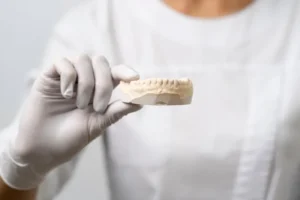Bone loss in dental implants can significantly impact the stability and longevity of your dental restoration. This common issue arises when the jawbone fails to support the implant adequately, often due to inadequate bone density or other underlying health conditions. Learning about the causes and preventative measures is crucial for anyone considering dental implants. This article explores how maintaining good oral hygiene, opting for regular dental check-ups, and choosing a qualified dental specialist can help mitigate the risk of bone loss, ensuring your dental implants remain secure and functional for years to come.
What is Bone Loss in Dental Implants?
In the realm of dental implantology, one of the most critical challenges we face is the issue of bone loss. This phenomenon can jeopardize the stability and longevity of dental implants, leading to potential complications and the need for further interventions. Understanding bone loss, its causes, and its implications is vital for both dental professionals and patients aiming for successful implant outcomes.
Bone loss around dental implants, also known as peri-implant bone loss, can significantly impact the effectiveness of an implant. Without the supporting bone, implants can fail to secure prosthetic teeth properly, leading to discomfort, impaired function, and aesthetic issues. Therefore, addressing bone loss proactively is essential for maintaining the efficacy and health of dental implants.
To properly manage bone loss, it’s important to diagnose it early and understand the underlying causes. By doing so, we can implement appropriate measures to mitigate its effects and ensure the long-term success of dental implant treatments.
Definition and Causes
Bone loss in dental implants refers to the reduction in bone density and volume around the implant site. This condition can be influenced by several factors, resulting in a gradual degradation of the bone structure that supports the implant. The severity of bone loss can vary, but it generally leads to complications if not addressed promptly.
The primary cause of bone loss in dental implants is peri-implantitis, an inflammatory condition that affects the tissues surrounding the implant. Peri-implantitis is characterized by the formation of periodontal pockets around the implant, which harbor bacteria and exacerbate the inflammatory response. Over time, this inflammation can erode the supporting bone. Several factors can contribute to the development of peri-implantitis and subsequent bone loss, including:
- Poor oral hygiene: Inadequate brushing and flossing can lead to plaque and tartar buildup, fostering bacterial growth and inflammation.
- Systemic conditions: Diseases such as diabetes and osteoporosis can impair the body’s ability to heal and maintain bone density.
- Smoking: Tobacco use is linked to increased risk of peri-implantitis due to its negative effects on blood circulation and immune response.
- Biomechanical factors: Poor implant positioning, excessive biting forces, and ill-fitting prosthetics can stress the bone and surrounding tissues.
Understanding these causes helps in developing strategies to prevent bone loss and manage peri-implantitis effectively. Regular dental check-ups, proper oral hygiene practices, and addressing systemic health issues are pivotal in maintaining healthy bone structures around implants.
How to Prevent Bone Loss in Dental Implants
Ensuring the longevity and success of dental implants hinges significantly on preventing bone loss. Bone loss can not only compromise the stability of implants but can also lead to more severe conditions such as peri-implantitis. By implementing specific preventive measures, patients can enhance their chances of maintaining healthy implants. Below, we explore some effective strategies for preventing bone loss in dental implants.
These strategies revolve around maintaining excellent oral hygiene, adhering to regular dental check-ups, and ensuring that implants are placed correctly. All these actions contribute to the overall health of dental implants, significantly reducing the risk of bone loss and other complications.
Maintaining Good Oral Hygiene
Consistent and thorough oral hygiene is the first line of defense against bone loss in dental implants. Plaque accumulation around dental implants can lead to inflammation and infections, which may eventually result in peri-implantitis. Hence, maintaining good oral hygiene is crucial.
Patients are advised to follow these practices:
- Brush twice daily with a soft-bristle toothbrush to remove plaque and prevent bacteria build-up.
- Floss daily to eliminate food particles and plaque from between the teeth and around the implant.
- Use an antimicrobial mouthwash to reduce oral bacteria that could lead to infection.
- Consider using interdental brushes or water flossers for added cleaning around implants.
Developing a daily oral hygiene routine is essential for protecting the surrounding bone structure and ensuring the long-term success of dental implants.
Regular Dental Check-Ups
Regular dental check-ups play a vital role in the early detection and management of potential problems that could lead to bone loss. Dentists can monitor the health of dental implants through routine examinations and take necessary actions if any issues are identified.
During these check-ups, the dentist will:
- Perform professional cleanings to remove tartar and plaque.
- Conduct X-rays to monitor the bone levels around the implants.
- Assess the health of the surrounding gum tissues.
- Provide personalised advice on maintaining oral hygiene.
Seeing a dentist regularly ensures that any signs of peri-implantitis or other complications are addressed promptly, preventing further bone loss and potential implant failure.
Proper Implant Placement Techniques
The technique used to place dental implants significantly affects their long-term success and the prevention of bone loss. Proper placement can ensure optimal integration with the bone and reduce the risk of complications.
Some key aspects of proper implant placement include:
- Conducting a thorough assessment of the patient’s bone quality and quantity.
- Choosing the appropriate implant size and type for the specific clinical situation.
- Employing advanced imaging techniques, such as CT scans, to guide precise implant placement.
- Using minimally invasive surgical techniques to preserve as much bone as possible.
By ensuring that implants are placed correctly, dental professionals can greatly reduce the chance of bone loss and enhance the stability and longevity of the implants.
In conclusion, preventing bone loss in dental implants involves a multi-faceted approach, including maintaining good oral hygiene, attending regular dental check-ups, and ensuring proper implant placement techniques. By adhering to these strategies, patients can enjoy the benefits of their dental implants for many years. For more in-depth information on these topics and other dental implant care tips, be sure to explore our other articles.
Treatment Options for Bone Loss in Dental Implants
Bone loss around dental implants, often referred to as peri-implantitis, can present significant challenges for both patients and dental professionals. The early diagnosis and timely treatment of this condition are crucial to prevent further complications such as soft tissue infection, mobility of the implant, and potential implant failure. Understanding and implementing effective treatment options are key to maintaining oral health and the longevity of dental implants.
Several approaches are available for addressing bone loss in dental implants. Each method has its own set of advantages and is chosen based on the severity of the bone loss and the specific needs of the patient. Two of the most commonly utilized treatments are bone grafting and regenerative procedures.
Bone Grafting
Bone grafting is one of the most established methods for treating bone loss in dental implants. It involves the transplantation of bone tissue to the affected area to promote new bone growth and provide a stable foundation for the implant. This can be done using the patient’s own bone (autograft), a donor’s bone (allograft), or synthetic materials (alloplast).
The success of bone grafting relies on several factors, including the health of the patient, the extent of bone loss, and the type of graft material used. Studies have shown that bone grafting can significantly enhance bone density and volume around the implant, making it possible to achieve a more secure and long-lasting result. There are different techniques within bone grafting, such as:
- Sinus Lift: Often used for implants in the upper jaw, this technique elevates the sinus membrane to create space for additional bone.
- Ridge Expansion: This involves widening the jawbone to make space for the implant by splitting the bone along its length.
Regenerative Procedures
Regenerative procedures aim to restore the lost bone and surrounding soft tissue to their original state. These procedures often involve the use of biomaterials like bone morphogenetic proteins (BMPs) and growth factors that stimulate the body’s natural healing processes. The goal is to create a conducive environment for the regrowth of bone and periodontal tissues.
A significant aspect of regenerative procedures is Guided Bone Regeneration (GBR), which uses barrier membranes to direct the growth of new bone. GBR has shown promising results, particularly when used in conjunction with bone grafting materials.
Another advanced technique is the use of Platelet-Rich Plasma (PRP) or Platelet-Rich Fibrin (PRF). These concentrates of platelets and growth factors derived from the patient’s own blood are applied to the surgical site to accelerate healing and bone regeneration. Studies indicate that PRP and PRF can significantly enhance the success rates of bone grafting procedures.
In cases where soft tissue complications such as fistulas or excessive bleeding are present, soft tissue grafts may be combined with regenerative techniques to ensure a holistic approach to treatment. This not only addresses the bone loss but also enhances the overall health and integrity of the tissues surrounding the implant.
If you’re interested in learning more about maintaining and improving your oral health, be sure to read our other articles on advanced dental treatments and preventative care strategies.
Addressing Bone Loss in Dental Implants
Understanding the concerns about bone loss in dental implants is crucial for maintaining oral health and the longevity of the implants. Here are some frequently addressed aspects of this condition.
What is peri-implantitis and how does it relate to bone loss in dental implants?
Peri-implantitis is an inflammatory condition affecting the tissues surrounding a dental implant, often leading to progressive bone loss. It can be triggered by various factors including bacterial infections, biomechanical stress, and improper oral hygiene. The main symptoms include swelling, bleeding upon probing, suppuration, and sometimes mobility of the implant if significant bone loss occurs.
How can bone loss around dental implants be prevented?
Preventing bone loss begins with meticulous oral hygiene and regular dental check-ups, ensuring that the implants and surrounding gums are clean and free of harmful bacteria. Avoiding smoking and managing systemic health conditions can also reduce the risk. Periodic professional monitoring and cleaning of the implant sites play a critical role in preventing peri-implantitis and associated bone loss.

My name is Salman Kapa, a 73-year-old expert in bone regeneration and dental implantology. With decades of experience in the field, I am dedicated to advancing our understanding of oral health and hygiene. Through my research and writing, I aim to contribute to the development of innovative solutions in dental care.




